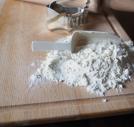Neonatal Diabetes Mellitus
Type 1 Diabetes and Type 2 Diabetes are polygenic, meaning that the disease results from the action of more than one gene. Some rare forms of diabetes are the result of mutation of a single gene (monogenic).
Neonatal Diabetes Mellitus (NDM) is a monogenic form of diabetes that presents within the first six months after birth.
NDM is extremely rare, occurring in 1 in 100,000–500,000 live births. Infants who suffer from NDM do not make enough insulin. For about half the children who develop NDM, the condition is lifelong, and is characterized as Permanent Neonatal Diabetes Mellitus (PNDM.) The remaining cases are transient in nature, generally disappearing by 18 months of age, but reappearing later in life, often during times of stress, like puberty or pregnancy. This is termed Transient Neonatal Diabetes Mellitus (TNDM).
NDM is often initially mistaken for Type 1 Diabetes, which also strikes young children. However, Type 1 Diabetes usually does not appear until the child is at least six months of age.
Temporary Neonatal Diabetes Mellitus (TNDM)
Children who are born with TNDM are generally much smaller than the average newborn, because TNDM is considered a developmental disorder of insulin production, resulting in intrauterine growth retardation (IUGR). Some of these children will fail to gain weight or achieve normal growth levels (failure to thrive). However, children who are diagnosed very early and receive appropriate therapies can achieve normal growth and development.
Symptoms include thirst, frequent urination and dehydration. Blood glucose levels will be elevated. This hyperglycemia may result in ketoacidosis if not diagnosed quickly. Diagnosis is based on blood glucose readings.
Permanent Neonatal Diabetes Mellitus (PNDM)
Children born with PNDM develop diabetes during the late prenatal period or early postnatal period, for which reason they don’t usually exhibit IUGR. Some children with PNDM develop a set of neurological problems, including developmental delay and recurrent seizures (epilepsy). This is known as DEND syndrome. A less severe form of this syndrome, known as intermediate DEND syndrome, causes a less serious developmental delay and does not include epilepsy.
A small number of children born with PNDM have an underdeveloped pancreas. This results in lifelong digestive issues and an inability to absorb fat-soluble vitamins.
Treatment
Children born with either TNDM or PNDM will need insulin therapy in order to gain and maintain weight and growth, particularly in children with IUGR. They should also be receiving a high caloric intake.
Children with TNDM should also be monitored closely throughout their lives for re-development of diabetes.
Sources: National Kidney and Urologic Diseases Information Clearinghouse (NKUDIC) , National Institutes of Health and Orphanet Journal of Rare Diseases


































